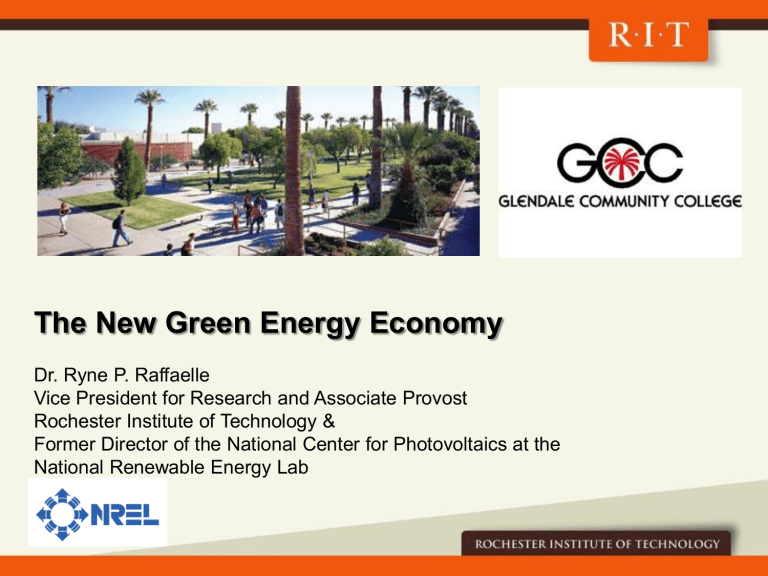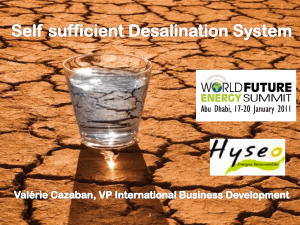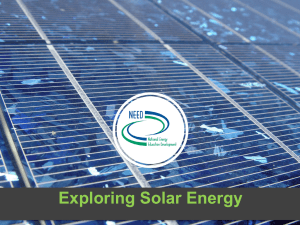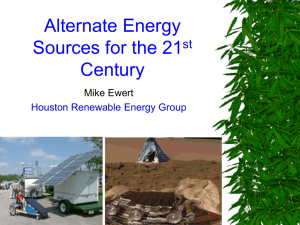Raffaelle_NewGreenEnergyEconomy

The New Green Energy Economy
Dr. Ryne P. Raffaelle
Vice President for Research and Associate Provost
Rochester Institute of Technology &
Former Director of the National Center for Photovoltaics at the
National Renewable Energy Lab
The New Green Energy
Economy is all about how we will meet the exponentially growing need for energy in a way that is sustainable.
The word sustainability is derived from the Latin sustinere
( tenere , to hold; sus , up).
Dictionaries provide more than ten meanings for sustain , the main ones being to “maintain",
"support", or "endure.”
“Sustainable Development is development that meets the needs of the present without compromising the ability of future generations to meet their own needs.”
Brundtland Commission of the United
Nations on March 20, 1987.
For development to be truly sustainable, requires that it be socially acceptable, environmentally friendly, and economically viable.
More often than not, energy is the “long-pole” when it comes to sustainable development.
“Access to environmentally and socially sustainable energy is essential to reduce poverty. Globally, over 1.4 billion people are still without access to electricity. About 3 billion use solid fuels — wood, charcoal, coal, and dung for cooking and heating.” – World Bank, 2011
For every 1 American there are 3.9 people in India and 4.3 people in China who currently use a small fraction of the energy we do.
1931
“We are like tenant farmers chopping down the fence around our house for fuel when we should be using Nature's inexhaustible sources of energy — sun, wind and tide. ... I'd put my money on the sun and solar energy. What a source of power! I hope we don't have to wait until oil and coal run out before we tackle that.”
Thomas Edison, in conversation with Henry Ford and Harvey Firestone as quoted in Uncommon
Friends : Life with Thomas Edison, Henry Ford, Harvey Firestone, Alexis Carrel & Charles
Lindbergh (1987) by James Newton, p. 31
Fastest growing sector in the energy market is renewables, but we have a very long way to go!
~16% of global final energy consumption comes from renewables - 10% traditional biomass, 3.4% hydroelectricity,
2.8% new renewables (small hydro, modern biomass, wind, solar, geothermal, and biofuels).
REN 21, Renewable Energy Policy
Network for the 21 st Century
Renewable energy is energy which comes from natural resources such as sunlight, wind, rain, tides, and geothermal heat, which are renewable (naturally replenished).
Roughly 4.6 billion years ago . . .
“Let there be light”
What a source of power indeed…
The amount of sunlight that hits the
Earth's surface in one hour is enough to power the entire world for a year!
1839
Edmund Becquerel discovers the photovoltaic effect.
1860 - 1881
Auguste Mouchout was the first man to patent a design for a motor running on solar energy.
1872
John Ericsson's developed his “Sun
Motor.”
1940
Russell Ohl discovers the
“p-n junction”
1941
Russell Ohl receives a US
Patent 2402662, "Light sensitive device"
1954
AT&T Bell Labs unveils it new
“solar battery” developed by
Gerald Pearson, Daryl
Chapin, and Calvin Fuller which was the first modern silicon solar cell.
1950’s
The U.S. has the best solar energy resource of any major industrialized nation on the Earth.
Average insolation kWh/m 2 /day
10% 20% 30%
3.6 TW US Consumption
40%
PV Costs and Production
• PV prices have been in free-fall over past couple of years.
• Large differences in utility scale versus commercial rooftop and residential.
Reasons:
• Efficiency Increases
• Economies of Scale
• Increased Competition
23,889 MW
Worldwide PV production grew by >
100% in 2010!
~ 80% of PV production is in Asia
~ 80% of deployment is in Europe
Industry Trends
1,400
1,200
2008-2010 Production (MW) 1,228
1,100
1,250
1,000
900
950
800
700
600
600
400
450
490
397
400
200
260
215
250
190
237
500
200
103
550
400
290
360
272
399
210
750
595
473
-
805
520 525
300
282
504
704
498
2008 Production 2009 Production 2010E Production
Current U.S. Solar Energy Production
Solar Advisor Model with real inputs (i.e., South facing, 25 degree fixed tilt,4.3 kW DC system size,
Local, state, and federal incentives as of October
2010, and the PV system financed as part of a 30 year home loan)
25 Year 80% BOL warrantees are the industry standard.
<1% degradation/year
Arrays installed after 2000 have been much more reliable, especially in the case of thin films.
Building Integrated Photovoltaics
85kW Shell Solar
CIGS in Wales
In
Southern
California
216 Würth CIGS modules in Tübingen, Germany
Concentrating Photovoltaics
Inverted Metamorphic III-V Solar Cell
> 40% Efficient
Maricopa Solar | Maricopa County,
Arizona (Near Phoenix) | Salt River
Project (SRP)
1.5MW | Total of 60 SunCatcher ™
Power Systems.
Operating since January 2010.
Roll-to-roll Thin Films
• Markup on all materials (module, inverter, BoS) included in ‘Installer Overhead & Profit’
Residential $0.89/W
DC
, Commercial $0.55, Utility (fixed) $0.31
• Reflects inventory costs (interest during construction), contingency
Energy Storage can be achieved in a wide variety of ways including: compressed air, batteries, hydrogen, and flywheels.
Concentrated Solar Thermal
Pumped hydro energy storage
The rechargeable battery market has grown 6 fold over the past 20 years.
Li ion batteries have been the fastest growing part of that sector.
All Electric Vehicles from China
The Hydrogen Economy
“We do not inherit the earth, we borrow it from our children”
Thank You
Happy 50
th











